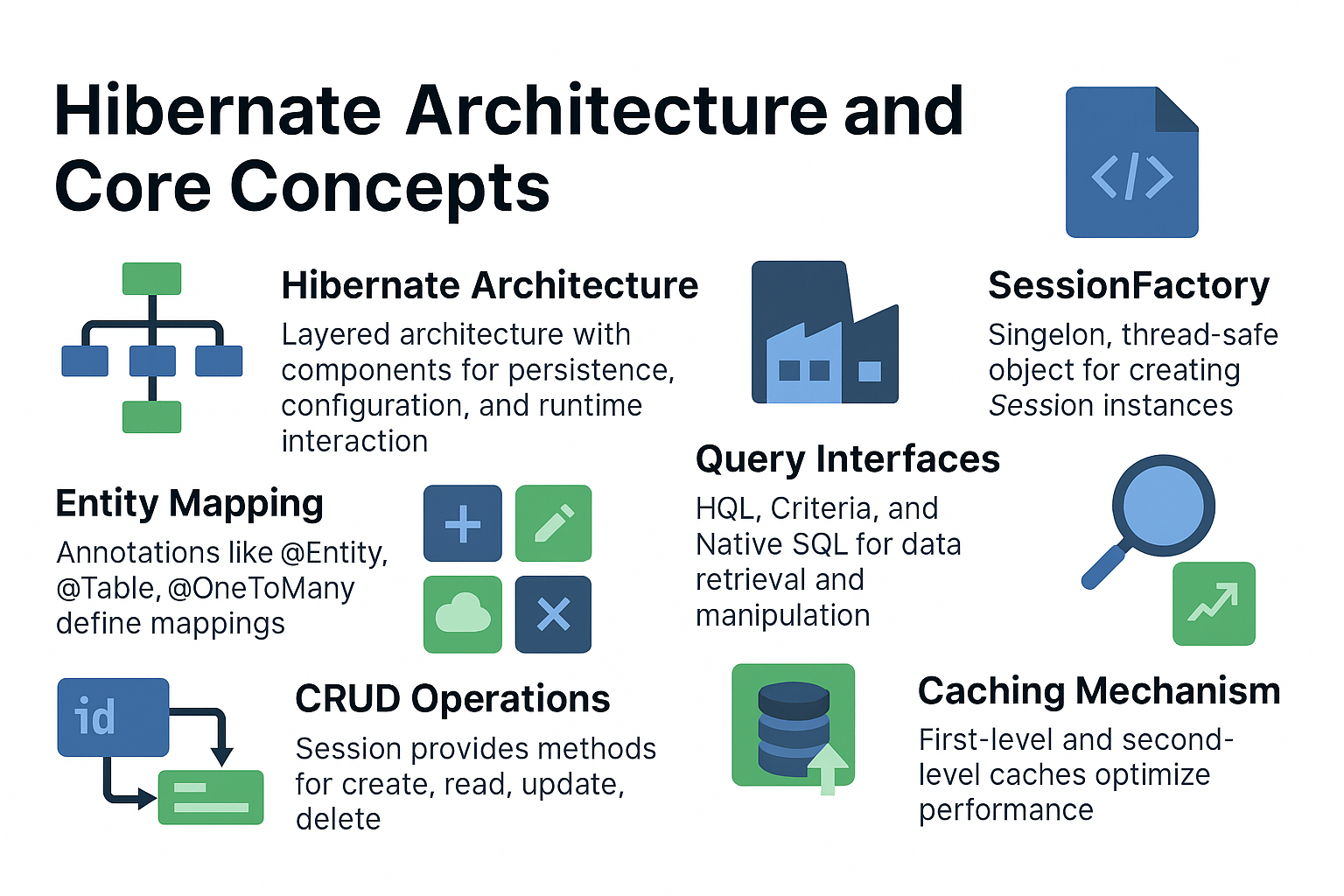When building Java applications, database persistence often becomes the most repetitive and error-prone part of development. Manually writing SQL and managing JDBC boilerplate code not only slows you down but also ties your code tightly to a specific database.
Hibernate, one of the most widely used Object-Relational Mapping (ORM) frameworks in Java, solves this by abstracting database operations into object-oriented APIs. At its core, Hibernate’s architecture is designed to handle object-to-database mapping, transactions, caching, and querying efficiently.
In this tutorial, we’ll dive deep into Hibernate architecture and core concepts, exploring how it works under the hood, the roles of its main components, and how developers can leverage it to build robust, scalable applications.
Hibernate Architecture Overview
Hibernate’s architecture is layered, designed to separate concerns for persistence, configuration, and runtime interaction.
Key Components
-
Configuration
Defines Hibernate settings and mappings, typically usinghibernate.cfg.xmlor annotations. -
SessionFactory
A heavyweight object created once per application. Responsible for providingSessionobjects. -
Session
A lightweight, single-threaded object representing a unit of work with the database. -
Transaction
Manages ACID properties and ensures atomic operations. -
Query Interfaces (HQL, Criteria, Native SQL)
Allow fetching and manipulating data. -
Caching Mechanism
Optimizes performance by reducing repeated database hits.
Here’s a high-level analogy:
- SessionFactory = Restaurant Kitchen (prepared once, shared by many customers)
- Session = Your dining table (specific to your meal, lightweight, short-lived)
- Transaction = Your meal order (all dishes must arrive correctly or none at all)
- Caching = Waiter remembers your last order (reduces trips to the kitchen)
Configuration and Setup
Maven Dependency
<dependency>
<groupId>org.hibernate.orm</groupId>
<artifactId>hibernate-core</artifactId>
<version>6.4.1.Final</version>
</dependency>
Hibernate Configuration (hibernate.cfg.xml)
<hibernate-configuration>
<session-factory>
<property name="hibernate.connection.driver_class">com.mysql.cj.jdbc.Driver</property>
<property name="hibernate.connection.url">jdbc:mysql://localhost:3306/testdb</property>
<property name="hibernate.connection.username">root</property>
<property name="hibernate.connection.password">root</property>
<property name="hibernate.dialect">org.hibernate.dialect.MySQL8Dialect</property>
<property name="hibernate.hbm2ddl.auto">update</property>
<property name="hibernate.show_sql">true</property>
</session-factory>
</hibernate-configuration>
Core Concepts and Annotations
Entity Mapping Example
import jakarta.persistence.*;
@Entity
@Table(name = "students")
public class Student {
@Id
@GeneratedValue(strategy = GenerationType.IDENTITY)
private Long id;
@Column(name = "student_name", nullable = false)
private String name;
@ManyToOne
@JoinColumn(name = "course_id")
private Course course;
// getters and setters
}
Common Annotations
@Entity→ Marks a class as a Hibernate entity.@Table→ Maps to a database table.@Id→ Primary key.@GeneratedValue→ Auto-generation strategies.@OneToMany,@ManyToOne,@ManyToMany→ Relationship mappings.
CRUD Operations with Hibernate
Create
Session session = factory.openSession();
Transaction tx = session.beginTransaction();
Student student = new Student();
student.setName("Alice");
session.persist(student);
tx.commit();
session.close();
Read
Session session = factory.openSession();
Student student = session.get(Student.class, 1L);
System.out.println(student.getName());
session.close();
Update
Session session = factory.openSession();
Transaction tx = session.beginTransaction();
Student student = session.get(Student.class, 1L);
student.setName("Updated Name");
session.update(student);
tx.commit();
session.close();
Delete
Session session = factory.openSession();
Transaction tx = session.beginTransaction();
Student student = session.get(Student.class, 1L);
session.remove(student);
tx.commit();
session.close();
Querying in Hibernate
HQL Example
List<Student> students = session.createQuery("FROM Student WHERE name = :name", Student.class)
.setParameter("name", "Alice")
.list();
Criteria API
CriteriaBuilder cb = session.getCriteriaBuilder();
CriteriaQuery<Student> cq = cb.createQuery(Student.class);
Root<Student> root = cq.from(Student.class);
cq.select(root).where(cb.equal(root.get("name"), "Alice"));
List<Student> students = session.createQuery(cq).getResultList();
Native SQL
List<Object[]> results = session.createNativeQuery("SELECT * FROM students").list();
Fetching Strategies and Caching
- Lazy Loading (default) → Loads data only when accessed. Like ordering food only when hungry.
- Eager Loading → Loads everything upfront, even if not needed.
- First-Level Cache → Session-level cache, enabled by default.
- Second-Level Cache → Application-level, using EHCache or Infinispan.
- Query Cache → Stores query results for faster retrieval.
Real-World Integration with Spring Boot
Spring Boot simplifies Hibernate setup with Spring Data JPA:
spring.datasource.url=jdbc:mysql://localhost:3306/testdb
spring.datasource.username=root
spring.datasource.password=root
spring.jpa.hibernate.ddl-auto=update
spring.jpa.show-sql=true
Repository interface:
public interface StudentRepository extends JpaRepository<Student, Long> {}
Common Pitfalls and Anti-Patterns
- N+1 Select Problem → Too many queries when fetching associations. Fix with
JOIN FETCH. - Improper Cascade Usage → Accidental data loss if cascade is misconfigured.
- Eager Fetching Everywhere → Slows down performance and loads unnecessary data.
Best Practices
- Use lazy fetching unless eager is necessary.
- Implement DTOs for APIs instead of exposing entities.
- Leverage batch fetching and query tuning.
- Use profiling tools (Hibernate statistics, JProfiler) to monitor queries.
- Prefer
JOINEDinheritance for normalized schemas.
📌 Hibernate Version Notes
Hibernate 5.x
- Uses
javax.persistencenamespace. - Classic
SessionFactoryconfiguration. - Legacy Criteria API.
Hibernate 6.x
- Migrated to
jakarta.persistence. - Enhanced SQL support.
- Improved bootstrapping API.
- Modern query API with better performance.
Conclusion and Key Takeaways
- Hibernate architecture revolves around SessionFactory, Session, Transaction, and Query APIs.
- It abstracts database interactions into object-oriented APIs, reducing boilerplate code.
- Caching and fetching strategies can greatly impact performance.
- Correct use of annotations, mappings, and transactions ensures scalable enterprise applications.
- Hibernate 6 modernizes the framework with Jakarta EE compliance and new query APIs.
FAQ: Expert-Level Hibernate Questions
-
What’s the difference between Hibernate and JPA?
JPA is a specification, Hibernate is an implementation with extra features. -
How does Hibernate caching improve performance?
By reducing repeated database hits using session-level and second-level caches. -
What are the drawbacks of eager fetching?
It loads unnecessary data upfront, impacting memory and performance. -
How do I solve the N+1 select problem in Hibernate?
UseJOIN FETCH, batch fetching, or entity graphs. -
Can I use Hibernate without Spring?
Yes, Hibernate can be used standalone with XML or programmatic configuration. -
What’s the best strategy for inheritance mapping?
UseJOINEDfor normalized schemas,SINGLE_TABLEfor performance. -
How does Hibernate handle composite keys?
Through@EmbeddedIdor@IdClass. -
How is Hibernate 6 different from Hibernate 5?
Hibernate 6 usesjakarta.persistence, supports enhanced SQL, and has modern APIs. -
Is Hibernate suitable for microservices?
Yes, but lightweight DTOs and stateless sessions are recommended. -
When should I not use Hibernate?
Avoid when raw SQL performance is critical (analytics, ETL jobs).
